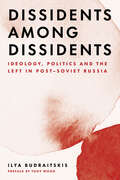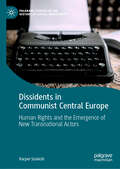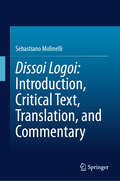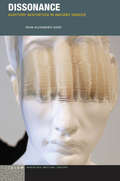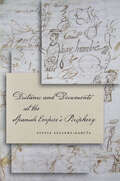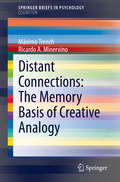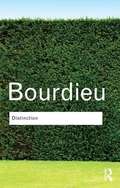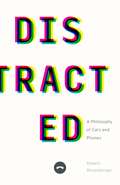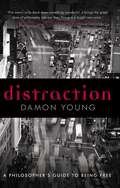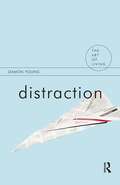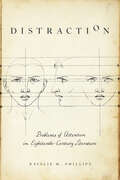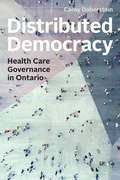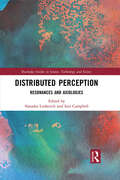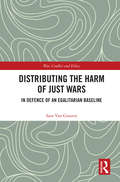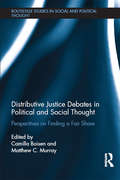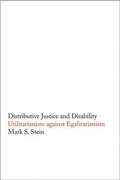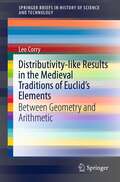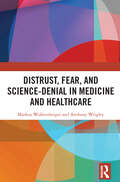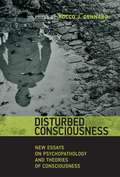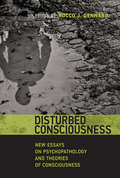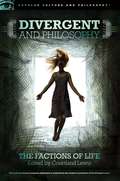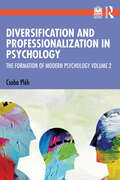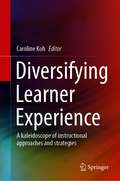- Table View
- List View
Dissidents among Dissidents: Ideology, Politics and the Left in Post-Soviet Russia
by Ilya BudraitskisHow have the fall of the USSR and the long dominance of Putin reshaped Russian politics and culture?Ilya Budraitskis, one of the country's most prominent leftist political commentators, explores the strange fusion of free-market ideology and postmodern nationalism that now prevails in Russia, and describes the post-Soviet evolution of its left. He incisively describes the twists and contradictions of the Kremlin's geopolitical fantasies, which blend up-to-date references to "information wars" with nostalgic celebrations of the tsars of Muscovy. Despite the revival of aggressive Cold War rhetoric, he argues, the Putin regime takes its bearings not from any Soviet inheritance, but from reactionary thinkers such as the White émigré Ivan Ilyin.Budraitskis makes an invaluable contribution by reconstructing the forgotten history of the USSR's dissident left, mapping an entire alternative tradition of heterodox Marxist and socialist thought from Khrushchev's Thaw to Gorbachev's perestroika. Doubly outsiders, within an intelligentsia dominated by liberal humanists, they offer a potential way out of the impasse between condemnations of the entire Soviet era and blanket nostalgia for Communist Party rule--suggesting new paths for the left to explore.
Dissidents in Communist Central Europe: Human Rights and the Emergence of New Transnational Actors (Palgrave Studies in the History of Social Movements)
by Kacper SzuleckiThis monograph traces the history of the dissident as a transnational phenomenon, exploring Soviet dissidents in Communist Central Europe from the mid-1960s until 1989. It argues that our understanding of the transnational activist would not be what it is today without the input of Central European oppositionists and ties the term to the global emergence and evolution of human rights. The book examines how we define dissidents and explores the association of political resistance to authoritarian regimes, as well as the impact of domestic and international recognition of the dissident figure. Turning to literature to analyse the meaning and impact of the dissident label, the book also incorporates interviews and primary accounts from former activists. Combining a unique theoretical approach with new empirical material, this book will appeal to students and scholars of contemporary history, politics and culture in Central Europe.
Dissoi Logoi: Introduction, Critical Text, Translation, and Commentary
by Sebastiano MolinelliThis new critical edition of Dissoi Logoi starts from a codicological analysis that is unprecedented in scope (the studied codices are twenty-six) and depth (their material, dimensions, transmitted works, provenance, date, scribe, first possessors, and current place of conservation are considered). On this basis, a new stemma codicum and a new Greek critical text with parallel English translation are offered. The extensive introduction reconstructs the manuscript and printed transmission of the text and sheds new light on its nature and its reception in antiquity. Dissoi Logoi appears to have been written between 355 and 338 BCE, in an Eastern form of Doric κοινή, by a sophist who aimed to promote his course. It likely worked as a source for Sextus Empiricus, which contributes to explaining the work’s collocation at the end of Sextus' codices. The third and final part of the book consists in a two-level commentary. First, the Structural Commentary looks into blocks of chapters from a rhetorical and philosophical perspective. Then, the Lemmatic Commentary delves into the most salient lemmas of the text, covering textual, linguistic, literary, and historical issues as well.
Dissonance: Auditory Aesthetics in Ancient Greece (Idiom: Inventing Writing Theory)
by Sean Alexander GurdIn the four centuries leading up to the death of Euripides, Greek singers, poets, and theorists delved deeply into auditory experience. They charted its capacity to develop topologies distinct from those of the other senses; contemplated its use as a communicator of information; calculated its power to express and cause extreme emotion. They made sound too, artfully and self-consciously creating songs and poems that reveled in sonorousness. Dissonance reveals the commonalities between ancient Greek auditory art and the concerns of contemporary sound studies, avant-garde music, and aesthetics, making the argument that “classical” Greek song and drama were, in fact, an early European avant-garde, a proto-exploration of the aesthetics of noise. The book thus develops an alternative to that romantic ideal which sees antiquity as a frozen and silent world.
Distance and Documents at the Spanish Empire's Periphery
by Sylvia Sellers-GarcíaThe Spanish Empire is famous for being, at its height, the realm upon which "the sun never set." It stretched from the Philippines to Europe by way of the Americas. And yet we know relatively little about how Spain managed to move that crucial currency of governance—paper—over such enormous distances. Moreover, we know even less about how those distances were perceived and understood by people living in the empire. This book takes up these unknowns and proposes that by examining how documents operated in the Spanish empire, we can better understand how the empire was built and, most importantly, how knowledge was created. The author argues that even in such a vast realm, knowledge was built locally by people who existed at the peripheries of empire. Organized along routes and centralized into local nodes, peripheral knowledge accumulated in regional centers before moving on to the heart of the empire in Spain. The study takes the Kingdom of Guatemala as its departure point and examines the related aspects of documents and distance in three sections: part one looks at document genre, and how the creation of documents was shaped by distance; part two looks at the movement of documents and the workings of the mail system; part three looks at document storage and how archives played an essential part in the flow of paper.
Distant Connections: The Memory Basis of Creative Analogy (SpringerBriefs in Psychology)
by Máximo Trench Ricardo A. MinervinoAnalogical thinking lies at the core of human cognition, pervading from the most mundane to the most extraordinary forms of creativity. By connecting poorly understood phenomena to learned situations whose structure is well articulated, it allows reasoners to expand the boundaries of their knowledge. The first part of the book begins by fleshing out the debate around whether our cognitive system is well-suited for creative analogizing, and ends by reviewing a series of studies that were designed to decide between the experimental and the naturalistic accounts. The studies confirm the psychological reality of the surface bias revealed by most experimental studies, thus claiming for realistic solutions to the problem of inert knowledge. The second part of the book delves into cognitive interventions, while maintaining an emphasis on the interplay between psychological modeling and instructional applications. It begins by reviewing the first generation of instructional interventions aimed at improving the later retrievability of educational contents by highlighting their abstract structure. Subsequent chapters discuss the most realistic avenues for devising easily-executable and widely-applicable ways of enhancing access to stored knowledge that would otherwise remain inert. The authors review results from studies from both others and their own lab that speak of the promise of these approaches.
Distant Strangers
by Judith LichtenbergWhat must affluent people do to alleviate global poverty? This question has occupied moral and political philosophers for forty years. But the controversy has reached an impasse: approaches like utilitarianism and libertarianism either demand too much of ordinary mortals or else let them off the hook. In Distant Strangers, Judith Lichtenberg shows how a preoccupation with standard moral theories and with the concepts of duty and obligation have led philosophers astray. She argues that there are serious limits to what can be demanded of ordinary human beings, but this does not mean we must abandon the moral imperative to reduce poverty. Drawing on findings from behavioral economics and psychology, she shows how we can motivate better-off people to lessen poverty without demanding unrealistic levels of moral virtue. Lichtenberg argues convincingly that this approach is not only practically, but morally, appropriate.
Distinction: A Social Critique Of The Judgement Of Taste (Routledge Classics Ser.)
by Pierre BourdieuNo judgement of taste is innocent - we are all snobs. Pierre Bourdieu's Distinction brilliantly illuminates the social pretentions of the middle classes in the modern world, focusing on the tastes and preferences of the French bourgeoisie. First published in 1979, the book is at once a vast ethnography of contemporary France and a dissection of the bourgeois mind. In the course of everyday life we constantly choose between what we find aesthetically pleasing, and what we consider tacky, merely trendy, or ugly. Taste is not pure. Bourdieu demonstrates that our different aesth.
Distracted: A Philosophy of Cars and Phones
by Robert RosenbergerApplying insights from philosophy and cognitive science to address the urgent issue of smartphone-induced distracted driving Although the dangers of texting while driving are widely known, many people resist the idea that phone usage will impair their driving. And connectivity features in new cars have only made using technology behind the wheel more tempting. What will it take to change people&’s minds and behavior? Robert Rosenberger contends that a better understanding of why this combination of technologies is so dangerous could effectively adjust both habits and laws. Rosenberger brings together ideas from philosophy and cognitive science to leverage a postphenomenological perspective that reveals how our smartphones make us such bad drivers. Reviewing decades of empirical studies in cognitive science, he shows that we have developed habits of perception regarding our compulsive technology use—habits that may wrest our attention away from the road. Distracted develops innovative concepts for understanding technology-related habits and the ways that our relationships to our devices influence how we perceive the world. In turn, these ideas can help drivers be more cognizant of the effect that smartphone usage has on their perceptions, better inform efforts to enact stricter regulations, and help us all to be more reflective about the technologies that shape our lives.
Distraction: A Philosopher's Guide To Being Free
by Damon YoungWe all know what it is to be distracted—a feeling that our attention is not quite where it should be.Though it is not a new complaint, at work and at home, in our social lives and in the bedroom, our attention is often torn between one thing and another. What does it mean to be distracted, and why? In this insightful journey through the lives of philosophers, artists and great political thinkers, Damon Young shows how rewarding patient, sensitive and thoughtful attention to the world can be. He suggests that the opposite of a life of distraction is one of genuine freedom.
Distraction: A Philosopher's Guide To Being Free (The Art of Living)
by Damon YoungMost of us struggle with distraction every day: the familiar feeling that our attention is not quite where it should be. We feel it at work and at home and it can be frustrating and uncomfortable. But what is distraction? In his lucid, timely book, Damon Young shows that distraction is more than too many stimuli, or too little attention. It is actually a matter of value - to be distracted is to be torn away from what is worthwhile in life. And for Young, what is most worthwhile is freedom: not simply rights or legal liberties, but the capacity to patiently, creatively craft one's own life. Exploring the lives of such luminaries as Henri Matisse, Karl Marx, Seneca and Henry James, Young exposes distraction in work, technology, art, politics and intimacy. With warmth and wit, he reveals what is most valuable, and what is best avoided, in the pursuit of a life of one's own.
Distraction: Problems of Attention in Eighteenth-Century Literature
by Natalie M. PhillipsEnlightenment writers fiercely debated the nature of distraction in literature.Early novel reading typically conjures images of rapt readers in quiet rooms, but commentators at the time described reading as a fraught activity, one occurring amidst a distracting cacophony that included sloshing chamber pots and wailing street vendors. Auditory distractions were compounded by literary ones as falling paper costs led to an explosion of print material, forcing prose fiction to compete with a dizzying array of essays, poems, sermons, and histories. In Distraction, Natalie M. Phillips argues that prominent Enlightenment authors—from Jane Austen and William Godwin to Eliza Haywood and Samuel Johnson—were deeply engaged with debates about the wandering mind, even if they were not equally concerned about the problem of distractibility.Phillips explains that some novelists in the 1700s—viewing distraction as a dangerous wandering from singular attention that could lead to sin or even madness—attempted to reform diverted readers. Johnson and Haywood, for example, worried that contemporary readers would only focus long enough to "look into the first pages" of essays and novels; Austen offered wry commentary on the issue through the creation of the daft Lydia Bennet, a character with an attention span so short she could listen only "half-a-minute." Other authors radically redefined distraction as an excellent quality of mind, aligning the multiplicity of divided focus with the spontaneous creation of new thought. Laurence Sterne’s Tristram Shandy, for example, won audiences with its comically distracted narrator and uniquely digressive form.Using cognitive science as a framework to explore the intertwined history of mental states, philosophy, science, and literary forms, Phillips explains how arguments about the diverted mind made their way into the century’s most celebrated literature. She also draws a direct link between the disparate theories of focus articulated in eighteenth-century literature and modern experiments in neuroscience, revealing that contemporary questions surrounding short attention spans are grounded in long conversations over the nature and limits of focus.
Distributed Democracy: Health Care Governance in Ontario (IPAC Series in Public Management and Governance)
by Carey DobersteinThe governance of health care in Ontario has long provided opportunities for citizens and stakeholders to participate, deliberate, and influence health care policy and investment decisions. Yet, despite providing opportunities for deliberation and influence amongst citizens, we don’t know how democratic the system actually is. Distributed Democracy advances an original analytical framework to guide an investigation of democracy and accountability relationships in complex policy making environments. Applying the analytical framework in the context of health care governance in Ontario from 2004–2019, Carey Doberstein shows that the popular criticisms of health care governance in Ontario are misplaced. The democratic system of local health care governance is often plagued by severed connections among the various layers of deliberation and policy-making. An incisive analysis with considerable relevance for policy-makers and across academic disciplines, Distributed Democracy makes an important contribution to our understanding of policy development and decision-making as well as the limitations and potential of distributed democratic accountability.
Distributed Perception: Resonances and Axiologies (Routledge Studies in Science, Technology and Society)
by Natasha LushetichContributors to this book include key theorists and practitioners from media theory, Native Science, bio-media and sound art, philosophy, art history and design informatics. Collectively, they examine the becoming-technique of animal-human- machinic perceptibilities; and micro-perceptions that lie beneath the threshold of known perceptions yet create energetic vibrations. Who, what, and where perceives, and how? What are the sedimentations, inscriptions and axiologies of animal, human and machinic perceptions? What are their perceptibilities? Deleuze uses the word ‘visibilities’ to indicate that visual perception isn’t just a physiological given but cues operations productive of new assemblages. Perceptibilities are, by analogy, spatio- temporal, geolocative, kinaesthetic, audio-visual, and haptic operations that are always already memory. In the case of strong inscriptions, they are also epigenetic events. The contributors show distributed perception to be a key notion in addressing the emergence and persistence of plant, animal, human and machine relations. An invaluable reference for students and scholars in a range of areas including Media Theory, Sociology, Philosophy, Art and Design.
Distributing the Harm of Just Wars: In Defence of an Egalitarian Baseline Approach (War, Conflict and Ethics)
by Sara Van GoozenThis book argues that the risk of harm in armed conflict should be divided equally between combatants and enemy non-combatants. International law requires that combatants in war take ‘all feasible precautions’ to minimize damage to civilian objects, injury to civilians, and incidental loss of civilian life. However, there is no clear explanation of what ‘feasible precautions’ means in this context, or what would count as sufficiently minimised incidental harm. As a result, it is difficult to judge whether a particular war or offensive actually satisfies this requirement. Just war theorists often consider it common sense that merely not intending to harm innocent civilians is not sufficient, but there is little clarity in the literature regarding what this means. One crucial question that is almost always overlooked is that of what the appropriate baseline distribution of risk should be. This book defends the Minimal Harm Requirement (MHR), which states that combatants should make an effort to reduce merely foreseen harm to enemy non-combatants to the lowest reasonable level. In order to assess which risk impositions are reasonable, and which are not, an egalitarian baseline should be adopted, suggesting that other things being equal risk of harm should be distributed equally between just combatants and unjust non-combatants. This book will be of much interest to students of just war theory, ethics, security studies and international relations.
Distributive Justice
by Michael AllinghamThis book presents a critical appraisal of the main theories of distributive justice. It develops the view that all such theories, or at least all liberal theories, may be seen as expressions of laissez-faire with compensations for factors that they consider to be morally arbitrary. More precisely, these theories are interpreted as specifying that the outcome of individuals acting independently, without the intervention of any central authority, is just, provided that those who fare ill for reasons that the theories deem to be arbitrary, for example, because they have fewer talents than others, receive compensation from those who fare well. The principal theories discussed are Rawls’s justice as fairness, Dworkin’s equality of resources, what may loosely be called Steiner-Vallentyne common ownership theories, and Nozick’s entitlements theory. The book considers the extent, if any, to which the theories examined can accommodate both liberty and equality. It concludes that if any such accommodation is possible it will be found in common ownership theories.
Distributive Justice Debates in Political and Social Thought: Perspectives on Finding a Fair Share (Routledge Studies in Social and Political Thought)
by Camilla Boisen and C. Murray MatthewWho has what and why in our societies is a pressing issue that has prompted explanation and exposition by philosophers, politicians and jurists for as long as societies and intellectuals have existed. It is a primary issue for a society to tackle this and these answers have been diverse. This collection of essays approaches some of these questions and answers to shed light on neglected approaches to issues of distribution and how these issues have been dealt with historically, socially, conceptually, and practically. The volume moves away from the more dominating and traditionally cast understandings of distributive justice and shows novel and unique ways to approach distributive issues and how these can help enlighten our course of action and thought today by creating new pathways of understanding. The editors and contributors challenge readers by exploring the role and importance of restorative justice within distributive justice, exploring the long shadow of practices of trusteeship, and concepts of social and individual rights and obligations in welfare and economic systems, social protection/provision schemes, egalitarian practices and post-colonial African political thought. Distributive Justice Debates in Political and Social Thought empowers the reader to cast a more critical and historically complete light on the idea of a fair share and the implications it has on societies and the individuals who comprise them.
Distributive Justice and Disability: Utilitarianism Against Egalitarianism
by Mark S. SteinTheories of distributive justice are most severely tested in the area of disability. In this book, Mark Stein argues that utilitarianism performs better than egalitarian theories in this area: whereas egalitarian theories help the disabled either too little or too much, utilitarianism achieves the proper balance by placing resources where they will do the most good. Stein offers what may be the broadest critique of egalitarian theory from a utilitarian perspective. He addresses the work of egalitarian theorists John Rawls, Ronald Dworkin, Amartya Sen, Bruce Ackerman, Martha Nussbaum, Norman Daniels, Philippe Van Parijs, and others. Stein claims that egalitarians are often driven to borrow elements of utilitarianism in order to make their theories at all plausible. The book concludes with an acknowledgment that both utilitarians and egalitarians face problems in the distribution of life-saving medical resources. Stein advocates a version of utilitarianism that would distribute life-saving resources based on life expectancy, not quality of life. Egalitarian theories, he argues, ignore life expectancy and so are again found wanting. Distributive Justice and Disability is a powerful and engaging book that helps to reframe the debate between egalitarian and utilitarian thinkers.
Distributivity-like Results in the Medieval Traditions of Euclid's Elements: Between Geometry and Arithmetic (SpringerBriefs in History of Science and Technology)
by Leo CorryThis book provides a fresh view on an important and largely overlooked aspect of the Euclidean traditions in the medieval mathematical texts, particularly concerning the interrelations between geometry and arithmetic, and the rise of algebraic modes of thought. It appeals to anyone interested in the history of mathematics in general and in history of medieval and early modern science.
Distrust, Fear, and Science-Denial in Medicine and Healthcare
by Anthony Wrigley Markus WolfensbergerOver recent decades, the decline of trust, mounting of fears, and increasing denial of science appear as a marked shift of societal attitudes towards many institutions and professionals. This book analyses these developments and looks at their role in medicine and healthcare, both in terms of the patient-physician relationship and for delivering high-quality healthcare, in order to establish why we need trust and what can be done to restore it. The book begins by offering a conceptual analysis and definition of trust, using a ‘pattern definition’ based upon typical features and common usage of the term, as well as the related concepts of hope, fear, and belief. It charts evidence for the decline of public trust in various professions, and then looks at the causes, as well as the accompanying growth of fear and the rejection of science. The study addresses possible options for restoring trust in medicine and healthcare, be it in individual physicians, in hospitals, or in managed care institutions. Written jointly by a medical doctor and an academic specialising in biomedical ethics, the book will be of interest to those working in the areas of biomedical ethics and law, medicine and healthcare, public health, philosophy, sociology, politics, and psychology.
Disturbed Consciousness
by Rocco J. GennaroIn Disturbed Consciousness, philosophers and other scholars examine various psychopathologies in light of specific philosophical theories of consciousness. The contributing authors -- some of them discussing or defending their own theoretical work -- consider not only how a theory of consciousness can account for a specific psychopathological condition but also how the characteristics of a psychopathology might challenge such a theory. Thus one essay defends the higher-order thought (HOT) theory of consciousness against the charge that it cannot account for somatoparaphrenia (a delusion in which one denies ownership of a limb). Another essay argues that various attempts to explain away such anomalies within subjective theories of consciousness fail.Other essays consider such topics as the application of a model of unified consciousness to cases of brain bisection and dissociative identity disorder; prefrontal and parietal underconnectivity in autism and other psychopathologies; self-deception and the self-model theory of subjectivity; schizophrenia and the vehicle theory of consciousness; and a shift in emphasis away from an internal (or brainbound) approach to psychopathology to an interactive one. Each essay offers a distinctive perspective from the intersection of philosophy, consciousness research, and psychiatry.ContributorsAlexandre Billon, Andrew Brook, Paula Droege, Rocco J. Gennaro, Philip Gerrans, William Hirstein, Jakob Hohwy, Uriah Kriegel, Timothy Lane, Thomas Metzinger, Erik Myin, Inez Myin-Germeys, Myrto Mylopoulos, Gerard O'Brien, Jon Opie, J. Kevin O'Regan, Iuliia Pliushch, Robert Van Gulick
Disturbed Consciousness: New Essays on Psychopathology and Theories of Consciousness (Philosophical Psychopathology)
by Rocco J. GennaroEssays defend, discuss, and critique specific theories of consciousness with respect to various psychopathologies.In Disturbed Consciousness, philosophers and other scholars examine various psychopathologies in light of specific philosophical theories of consciousness. The contributing authors—some of them discussing or defending their own theoretical work—consider not only how a theory of consciousness can account for a specific psychopathological condition but also how the characteristics of a psychopathology might challenge such a theory. Thus one essay defends the higher-order thought (HOT) theory of consciousness against the charge that it cannot account for somatoparaphrenia (a delusion in which one denies ownership of a limb). Another essay argues that various attempts to explain away such anomalies within subjective theories of consciousness fail.Other essays consider such topics as the application of a model of unified consciousness to cases of brain bisection and dissociative identity disorder; prefrontal and parietal underconnectivity in autism and other psychopathologies; self-deception and the self-model theory of subjectivity; schizophrenia and the vehicle theory of consciousness; and a shift in emphasis away from an internal (or brainbound) approach to psychopathology to an interactive one. Each essay offers a distinctive perspective from the intersection of philosophy, consciousness research, and psychiatry.ContributorsAlexandre Billon, Andrew Brook, Paula Droege, Rocco J. Gennaro, Philip Gerrans, William Hirstein, Jakob Hohwy, Uriah Kriegel, Timothy Lane, Thomas Metzinger, Erik Myin, Inez Myin-Germeys, Myrto Mylopoulos, Gerard O'Brien, Jon Opie, J. Kevin O'Regan, Iuliia Pliushch, Robert Van Gulick
Divergent and Philosophy
by Courtland LewisCourtland Lewis has scoured the planet to bring together the most talented faction members, factionless, and even a few from the Bureau to discuss the philosophy of Divergent.<P><P>Divergent and Philosophy begins by examining the personal struggles that all people face at some time: What sort of person should I be? What if I find out my life is a lie? What do I owe my parents? Am I normal? Once readers have finished answering these questions they're ready for the "choosing ceremony." Part two examines each faction, looking at its virtues, vices, and other features that will help readers pick the "right" faction. This part gives readers a glimpse into what it's like to be faced with the most important decision of our lives, the one that will forever determine who we are. Part three takes a step takes a step back, in order to question Chicago's ordering of society. Chicago is on the verge of revolution, but is this the result of the faction system itself, or is it the people within the factions that are behind the social discord? Part four shifts the focus individuals and those who hold power. Part five tells us how to recognize injustice.
Diversification and Professionalization in Psychology: The Formation of Modern Psychology Volume 2 (The Formation of Modern Psychology)
by Csaba PléhDiversification and Professionalization in Psychology offers readers a multicentric perspective on the history of social science and compares the developments in psychology in relation to the developments made in the other social and natural sciences. This is the second volume about the formation of modern psychology and provides a comprehensive look into the origins and developments of modern psychology. With a large geographical coverage, European developments are put into their own context in their own time. In doing this, the book explores different early schools, from social reductionists like Durkheim, Charles Blondel, and Maurice Halbwachs, to the social debates about relativism in Lévy-Bruhl, early Piaget, the beginnings of ethology, and the semiotic approach of Karl Bühler. These thinkers are placed in relation to the recent upsurge of different social and biological theories of the mind. Throughout, the author develops a detailed presentation of the thematic development of psychology and links the history of psychology to an outline of contemporary psychology. This is an invaluable introductory text for undergraduate students of the history of psychology and will also appeal to postgraduates, academics, and anyone interested in psychology or the history of science. It will also be of interest to graduate students of psychology, biology, sociology, and anthropology with a theoretical interest in the history of the field.
Diversifying Learner Experience: A kaleidoscope of instructional approaches and strategies
by Caroline KohThis book brings together strategies and innovations that educators from diverse educational contexts have conceptualized and implemented to cater to differences in academic ability, as well as in other domains such as psychosocial contexts and developmental needs. The emergence of IT and new technologies have altered the educational landscape and opened a multitude of opportunities for diverse modes of instruction catering to diverse student populations.The book addresses the gap in the literature with evidence-based reports of innovative strategies and approaches that are grounded in educational research. It identifies student differences in terms of academic ability and also, with regard to their cultural and social background, their developmental and psycho-emotional needs. It examines how new technologies are used in instructional approaches and how these innovative strategies diversify learner experiences. The book is a valuable resource to practitioners, researchers and educational administrators.
